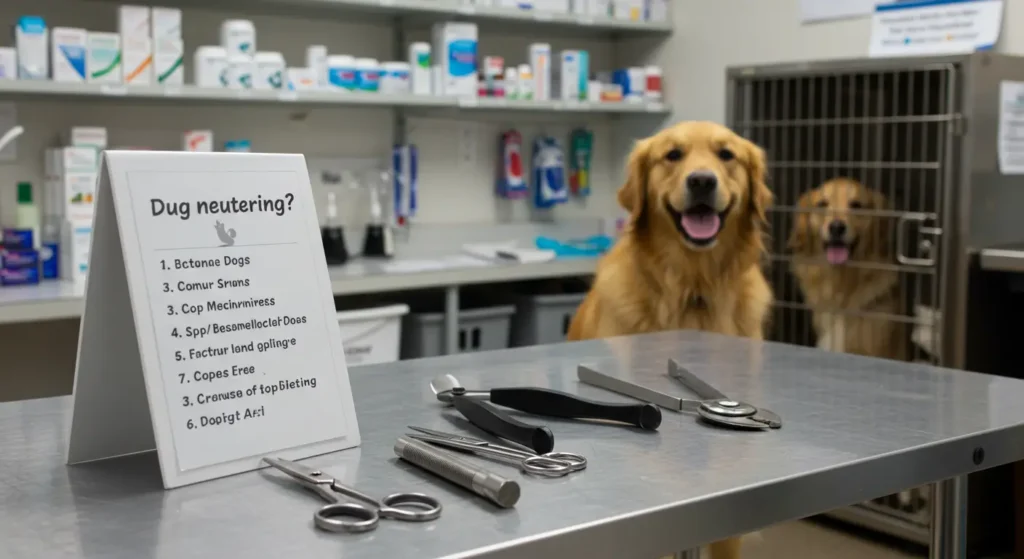Thinking about your dog’s health might make you wonder, why not neuter your dog? Neutering helps control pet numbers and prevents some health problems. But, it’s important to think about the downsides too.
Every year, 3.3 million dogs end up in shelters, often because of unwanted litters. This makes the decision to neuter or not very important.
Table of Contents
Understanding why not neuter your dog can also help in making an informed choice about their health and future.
Looking into the pros and cons of neutering is key. It affects your dog’s health and happiness. Not neutering can lead to health issues and cancers. But, neutering might change your dog’s natural behaviors and could cause surgery problems.
By knowing the good and bad sides, you can choose what’s best for your pet.
Talking to a vet is crucial when deciding. They can help based on your dog’s breed, size, and health. This way, you can make a choice that’s good for your dog, whether it’s neutering or not.
Understanding Dog Neutering and Its Implications
As a responsible dog owner, it’s key to grasp what dog neutering means for your pet’s health. Neutering is a surgery that takes away a dog’s reproductive parts, and understanding why not neuter your dog is just as important. It’s done to stop unwanted litters and lower health risks.
What is Dog Neutering?
Dog neutering, or spaying/neutering, is a common vet practice. It removes the reproductive organs to stop breeding and lower health risks.
The History of Routine Neutering
For decades, routine neutering has been a vet standard. But, new studies question the best age for neutering and its health effects.
Current Perspectives in Veterinary Medicine
Vets now focus on custom spay-neuter plans. They consider breed, age, sex, and lifestyle. It’s crucial to weigh neutering’s benefits and risks for your dog’s health and happiness.
- Reduced risk of certain health problems, such as testicular cancer and prostate disease
- Prevention of unwanted litters and reduction of pet overpopulation
- Potential impact on a dog’s behavior and temperament
| Procedure | Description |
|---|---|
| Ovariohysterectomy | Removal of the ovaries and uterus |
| Ovariectomy | Removal of the ovaries |
| Orchiectomy | Removal of the testicles |
The Biology Behind Why Not to Neuter Your Dog
Understanding the risks of not neutering a dog starts with knowing the biology. Neutering or spaying removes a dog’s reproductive organs. This stops them from having puppies. But, it can also lead to health problems like joint issues and some cancers.
Choosing between neutering vs spaying dogs depends on many factors. These include the dog’s breed, size, and health. Some breeds might face more health risks if neutered or spayed too soon.
Here are some important things to think about when deciding:
- Risks like joint disorders and cancers from neutering
- Benefits like less chance of some health problems
- Things like breed, size, and health status
Deciding to neuter or spay a dog needs careful thought. It’s also important to talk to a vet. Knowing the biology helps you make a choice that’s good for your dog’s health.
Health Considerations for Intact Male Dogs
As a dog owner, you know how important it is to think about your pet’s health. Neutering can help prevent some cancers, but it’s key to look at both sides. The cost of neutering varies by location and dog size, but the long-term health effects are crucial.
Research shows neutering might raise the risk of joint issues and some cancers in dogs. For example, a 2020 study found neutering big mixed-breed dogs before 1 year can lead to joint problems. Breeds like German Shepherds and Golden Retrievers might face even more risks if neutered too early.
Yet, neutering can also lower the risk of testicular cancer. It’s vital to think about your dog’s specific needs and health before deciding. You should talk to a vet to weigh the pros and cons for your pet.
| Breed | Neutering Age | Risk of Joint Disorders |
|---|---|---|
| German Shepherds | Before 1 year | Higher risk |
| Golden Retrievers | Before 1 year | Higher risk |
| Labradors | Before 1 year | Higher risk |
In conclusion, deciding to neuter your dog needs careful thought. By considering the benefits and risks, you can make a choice that’s best for your pet’s health and happiness.
Behavioral Impacts of Keeping Dogs Intact
When thinking about preventing pet overpopulation, it’s key to know how keeping dogs intact affects their behavior. While pet neutering benefits like less aggression and roaming are common, it’s important to fully understand the impact on your dog’s behavior before making a choice.
Studies show that intact dogs may act differently because of reproductive hormones. For instance, territory aggression often starts in adolescence, and same-sex aggression is more common in non-neutered males. But, neutering can also lead to increased anxiety and fear-based behaviors.
Some important facts to keep in mind are:
- Neutering male dogs can cut aggression towards other dogs by over 50%.
- Intact dogs are more likely to wander and show mounting and humping behaviors.
- Neutering can lower resource guarding behaviors, but might increase obsessive-compulsive disorder behaviors.
The choice to neuter or keep your dog intact should be made after careful thought. Understanding how reproductive hormones affect behavior and considering the pet neutering benefits will help you make a decision that’s best for your dog’s health and happiness.
Common Myths About Unneutered Dogs
It’s important to know the truth about unneutered dogs. Many pet owners believe false information. They think unneutered dogs are more aggressive and like to roam.
But, research shows these beliefs are not always right. Unneutered dogs might mark territory or show aggression. Yet, these behaviors can be controlled with the right training and care.
Debunking Aggression Misconceptions
Studies reveal aggression in dogs is often due to breeding, training, and socialization. It’s not just about being unneutered. Many unneutered dogs are friendly, while some neutered dogs can be aggressive.
Understanding Roaming Behaviors
Unneutered dogs roam to find a mate. But, this can be stopped with enough exercise, training, and attention. With the right care, the risks of not neutering a dog can be lowered.
Knowing the truth about these myths helps pet owners make better choices. Whether to neuter a dog is a personal decision. It’s key to weigh the risks and benefits, including the reasons for not neutering.
| Myth | Reality |
|---|---|
| Unneutered dogs are more aggressive | Aggression is linked to breeding, training, and socialization, not neutering status |
| Unneutered dogs will always roam | Roaming behaviors can be managed with exercise, training, and attention |
| Neutering is the only solution to population control | There are alternative methods to manage pet population, and why not neuter your dog is a question to consider |
Financial Aspects of Dog Neutering
Thinking about the cost of dog neutering? It’s key to look at the long-term savings. Neutering a dog costs about $315, while spaying one costs $465. But, low-cost clinics can do these for just $55 and $60.
Remember, not neutering your dog can lead to big medical bills later. These bills can be five to ten times more than spay/neuter surgery. For example, treating reproductive system cancer or pyometra can cost thousands.
Deciding when to neuter a dog involves weighing costs and benefits. Waiting too long can make some behaviors harder to change. But, neutering early can prevent health issues like uterine cancer in females.
Here’s a quick look at the average costs for dog neutering:
| Procedure | Average Cost | Low-Cost Clinic |
|---|---|---|
| Neutering | $315 | $55 |
| Spaying | $465 | $60 |

In summary, the cost of dog neutering is a big factor in your decision. By considering the costs and benefits, you can choose what’s best for your pet’s health and happiness.
Age Considerations: When Traditional Neutering Might Not Be Appropriate
Thinking about when to neuter a dog involves considering their age. The timing of neutering can affect a dog’s health and growth. Studies show that neutering age can influence the risk of health issues like joint problems and certain cancers.
Large breed dogs might face more health risks if neutered too early. Smaller breeds, however, might be more flexible with neutering timing without increasing disease risks. The American Pet Products Association reports that about 78% of dog owners in the U.S. have spayed or neutered their pets. The timing varies based on the dog’s breed and size.
Breed-Specific Timing
Toy breed dogs mature sexually between 6 to 9 months. Large and giant breeds take longer, usually between 16 to 18 months. It’s important to consider these factors when deciding when to neuter a dog. A study on 35 dog breeds showed significant differences in the effects of early neutering, emphasizing the need for a tailored approach.
When deciding between neutering and spaying, consider the risks and benefits. Spaying or neutering can prevent some health issues but might increase others, like joint disorders and certain cancers.
Size and Growth Factors
The size and growth rate of a dog also play a role in neutering decisions. Larger breeds face more health risks from early spaying or neutering than smaller breeds. When weighing the pros and cons, consider your dog’s breed, size, and growth rate.
| Breed Type | Maturation Age | Recommended Neutering Age |
|---|---|---|
| Toy breed | 6-9 months | Variable, depending on individual dog |
| Large breed | 16-18 months | After physical maturity, typically 1-2 years |
| Giant breed | 16-18 months | After physical maturity, typically 1-2 years |
Alternative Options to Traditional Neutering
When thinking about spaying and neutering pets, you might look into other choices. These options can offer similar benefits but with fewer risks than traditional methods.

Some people choose chemical neutering, which lowers testosterone in dogs. Others prefer vasectomy, a surgery that stops reproduction but keeps the reproductive organs.
Here are some key points to consider when evaluating alternative options to traditional neutering:
- Vasectomy: a surgical procedure that prevents reproduction without removing the reproductive organs, potentially reducing the risk of certain health issues
- Chemical neutering: a procedure that disrupts testosterone production in dogs, which can help reduce undesirable behaviors
- Ovary-Sparing Spay (OSS): a surgical procedure that removes the uterus but leaves the ovaries intact, which can help maintain hormone production
It’s crucial to talk to a vet before choosing an alternative. They can help pick the best option for your pet’s health and needs. This way, you can ensure your pet stays healthy and happy.
| Procedure | Description | Benefits |
|---|---|---|
| Vasectomy | A surgical procedure that prevents reproduction without removing the reproductive organs | Reduces the risk of certain health issues, such as testicular cancer |
| Chemical Neutering | A procedure that disrupts testosterone production in dogs | Helps reduce undesirable behaviors, such as aggression and roaming |
| Ovary-Sparing Spay (OSS) | A surgical procedure that removes the uterus but leaves the ovaries intact | Helps maintain hormone production, reducing the risk of certain health issues |
Responsible Pet Ownership Without Neutering
As a pet owner, you have a big role in stopping pet overpopulation. While neutering has many benefits, there are other ways to prevent unwanted litters. Understanding your pet’s needs and training them well can help prevent unwanted breeding.
There are nearly 2,000 affordable spay/neuter programs across the country. These programs help reduce unwanted litters and fight overpopulation. Also, trap/neuter/vaccinate/return (TNVR) programs for community cats are effective. Supporting these efforts and teaching others about spay/neuter can help your community.
Some key benefits of responsible pet ownership without neutering include:
- Reduced roaming behavior, leading to fewer traffic accidents and neighborhood complaints
- Lower risk of certain health issues, such as uterine infections and testicular cancer
- Increased opportunities for pet owners to educate children about spay/neuter and prevent rising overpopulation issues
By adopting responsible pet ownership and finding other ways to prevent unwanted litters, you can help make a better future for pets. Every small action you take can make a big difference. Remember, the benefits of neutering and responsible pet ownership are key to a better world for animals and humans.
| Benefits of Responsible Pet Ownership | Description |
|---|---|
| Reduced Roaming Behavior | Decreased risk of traffic accidents and neighborhood complaints |
| Improved Health | Lower risk of certain health issues, such as uterine infections and testicular cancer |
| Education and Awareness | Increased opportunities for pet owners to educate children about spay/neuter and prevent rising overpopulation issues |
Legal and Social Considerations for Intact Dogs
Thinking about not neutering your dog? It’s key to know the legal and social sides of it. Not neutering can lead to big challenges. In the U.S., laws about intact dogs vary by state.

Insurance can be a big worry for intact dog owners. Some insurers might charge more or not cover intact dogs. But, many owners think the good points of not neutering their dog are worth it.
Public Perception and Local Regulations
How people see intact dogs matters a lot. Some think they’re more aggressive. But, many owners say training and socializing can change that. Also, local rules like licensing and breed laws can affect you.
Choosing to neuter or not is a big decision. It’s important to think about the pros and cons. Knowing the legal and social sides helps you decide what’s best for you and your dog. For many, the good things about not neutering outweigh the bad.
| State | Intact Dog Regulations |
|---|---|
| California | Requires licensing and microchipping |
| New York | Prohibits breeding of intact dogs in certain areas |
| Florida | Requires spaying or neutering for adoption |
Conclusion: Making an Informed Decision About Your Dog’s Health
When thinking about neutering your dog, consider the benefits, costs, and the right time. Being a responsible pet owner means looking at what’s best for your dog. The American Society for the Prevention of Cruelty to Animals (ASPCA) says about 3.3 million dogs end up in shelters each year in the U.S. Neutering helps lower pet numbers and improves health.
Neutering stops testicular cancer and lowers prostate problems. It also helps with aggression and wandering. But, studies now say wait until your dog is at least one year old, especially big breeds, to avoid bone issues. Talk to your vet to find the best time for your dog’s neutering.
By making a smart choice about your dog’s health, you can give them a long, happy life.
FAQ
What is dog neutering and why is it often recommended?
Dog neutering, or spaying and neutering, is a vet procedure. It removes a dog’s reproductive organs. It’s often suggested to cut down on pet overpopulation and prevent health problems.
What are the benefits of neutering a dog?
Neutering a dog has many benefits. It lowers the risk of some cancers and stops unwanted litters. It can also make a dog’s behavior better by reducing aggression or wandering.
What are the risks associated with not neutering a dog?
Not neutering a dog can lead to several issues. It can cause unwanted litters and increase health risks like uterine infections or testicular cancer. It also raises the chance of behavioral problems like aggression or wandering.
When is the best time to neuter a dog?
The best time to neuter a dog varies. It depends on breed, size, and individual needs. Always talk to a vet to find the right time for your dog.
Are there alternatives to traditional neutering procedures?
Yes, there are other options besides traditional neutering. Chemical neutering and vasectomy offer some benefits without all the risks or side effects of traditional methods.
How can I be a responsible pet owner without neutering my dog?
You can still be a responsible pet owner without neutering. Keep your dog confined or supervised to prevent unwanted litters. Look into other ways to control population.
What are the legal and social considerations for owning an intact dog?
Owning an intact dog comes with legal, insurance, and social considerations. Research local laws, insurance, and public views to understand the challenges you might face.


2 thoughts on “Why Not Neuter Your Dog? Exploring the Reasons and Risks”
Comments are closed.